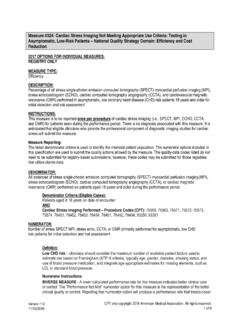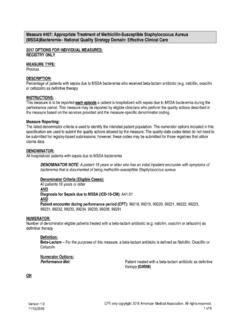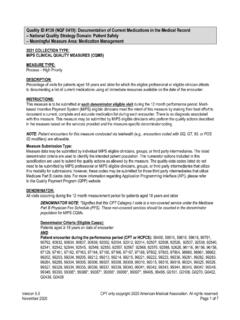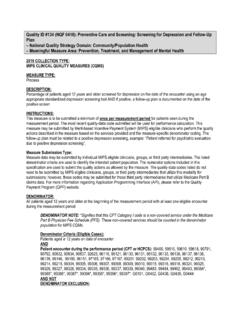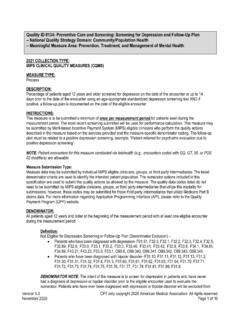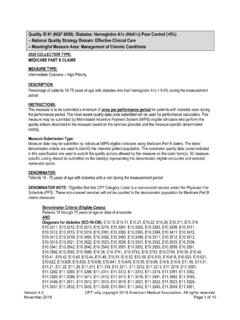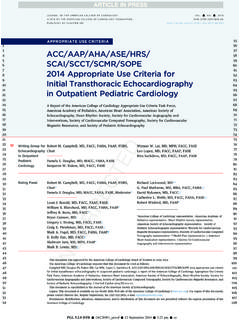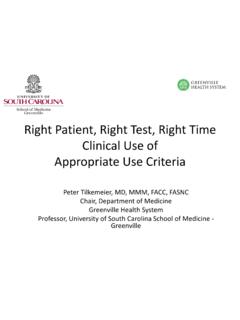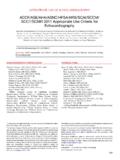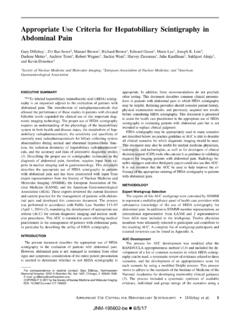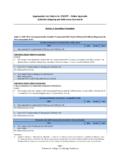Transcription of Quality ID #323: Cardiac Stress Imaging Not Meeting ...
1 Quality ID #323: Cardiac Stress Imaging Not Meeting appropriate Use criteria : Routine Testing After Percutaneous Coronary Intervention (PCI) National Quality Strategy Domain: Efficiency and Cost Reduction 2018 OPTIONS FOR INDIVIDUAL MEASURES: REGISTRY ONLY MEASURE TYPE: Efficiency DESCRIPTION: Percentage of all Stress single-photon emission computed tomography (SPECT) myocardial perfusion Imaging (MPI), Stress echocardiogram (ECHO), Cardiac computed tomography angiography (CCTA), and cardiovascular magnetic resonance (CMR) performed in patients aged 18 years and older routinely after percutaneous coronary intervention (PCI), with reference to timing of test after PCI and symptom status INSTRUCTIONS.
2 This measure is to be submitted once per procedure of Cardiac Stress Imaging ( , SPECT, MPI, ECHO, CCTA and CMR) for patients seen during the performance period. There is no diagnosis associated with this measure. It is anticipated that eligible clinicians who provide the professional component of diagnostic Imaging studies for Cardiac Stress will submit this measure. Measure Submission: The listed denominator criteria is used to identify the intended patient population. The numerator options included in this specification are used to submit the Quality actions allowed by the measure.
3 The Quality -data codes listed do not need to be submitted for registry-based submissions; however, these codes may be submitted for those registries that utilize claims data. DENOMINATOR: All instances of Stress single-photon emission computed tomography (SPECT) myocardial perfusion Imaging (MPI), Stress echocardiogram (ECHO), Cardiac computed tomography angiography (CCTA), or Cardiac magnetic resonance (CMR) performed on patients aged 18 years and older during the submission period Denominator criteria (Eligible Cases): Patients aged 18 years on date of encounter AND Cardiac Stress Imaging Performed Procedure Codes (CPT).
4 75559, 75563, 75571, 75572, 75573, 75574, 78451, 78452, 78453, 78454, 78491, 78492, 78494, 93350, 93351 NUMERATOR: Number of Stress SPECT MPI, Stress echo, CCTA and CMR performed in asymptomatic patients within 2 years of the most recent PCI Numerator Instructions: INVERSE MEASURE - A lower calculated performance rate for this measure indicates better clinical care or control. The Performance Not Met numerator option for this measure is the representation of the better clinical Quality or control. Submitting that numerator option will produce a performance rate that trends closer to 0%, as Quality increases.
5 For inverse measures, a rate of 100% means all of the denominator eligible patients did not receive the appropriate care or were not in proper control. NUMERATOR NOTE: A lower calculated performance rate for this measure indicates better clinical care or control. This measure is assessing overuse of Cardiac Stress Imaging in asymptomatic patients that received Version 02/11/2017 CPT only copyright 2017 American Medical Association. All rights reserved. Page 1 of 6 Version 12/11/2017 CPT only copyright 2017 American Medical Association.
6 All rights reserved. Page 1 of 6 PCI. Clinical Quality outcome is Cardiac Stress Imaging NOT performed on patient who is asymptomatic or low CHD risk. Numerator Options: Performance Met: Cardiac Stress Imaging performed primarily for monitoring of asymptomatic patient who had PCI within 2 years (G8963) OR Performance Not Met: Cardiac Stress Imaging test performed primarily for any other reason than monitoring of asymptomatic patient who had PCI within 2 years ( , symptomatic patient, patient greater than 2 years since PCI, initial evaluation, etc.)
7 (G8964) RATIONALE: Diagnostic testing, such as Stress SPECT MPI, Stress echocardiography, CCTA and CMR, is used to detect disease and provide risk assessment used to modify treatment strategies and approaches. Information provided by such testing can initiate, modify and stop further treatments for coronary heart disease (medications and revascularization) which have an impact on patient outcomes. In addition, false positives and false negatives can adversely impact the patient and their treatment outcomes. Lastly, radiation from Stress SPECT MPI and CCTA poses a minimal but still important consideration for patient safety.
8 Ensuring proper patient selection can avoid using resources in patients not expected to benefit from the testings and for which the associated risks would be unnecessary. CLINICAL RECOMMENDATION STATEMENTS: 2005 PCI Guidelines Text (No recommendations) Neither exercise testing nor radionuclide Imaging is indicated for the routine, periodic monitoring of asymptomatic patients after PCI without specific indications. 2011 ACCF/AHA/SCAI Guideline for Percutaneous Coronary Intervention A Report of the American College of Cardiology Foundation/American Heart Association Task Force on Practice Guidelines and the Society for Cardiovascular Angiography and Interventions (J Am Coll Cardiol, 2011) AUC Indications 2013 ACCF/AHA/ASE/ASNC/HFSA/HRS/SCAI/SCCT/SCM R/STS multimodality appropriate use criteria for the detection and risk assessment of stable ischemic heart disease (J Am Coll Cardiol.)
9 2014 Feb 4;63(4):380-406) Indication 69: Post Revascularization: Asymptomatic (Without Ischemic Heart Disease) and less than 2 years after PCI Rarely appropriate 2008 Appropriateness criteria for Stress Echocardiography Indication 39: Risk Assessment: Post-Revascularization (PCI or CABG): Asymptomatic: Asymptomatic (eg, silent ischemia) prior to previous revascularization AND less than 2 years after PCI - Inappropriate (3) Indication 40: Risk Assessment: Post-Revascularization (PCI or CABG): Asymptomatic.
10 Symptomatic prior to previous revascularization AND less than 2 years after PCI - Inappropriate (2) ACCF/ASE/AHA/ASNC/HFSA/HRS/SCAI/SCCM/SCC T/SCMR 2011 appropriate Use criteria for Echocardiography (J Am Coll Cardiol, 2011) 2009 appropriate Use criteria for Cardiac Radionuclide Imaging Version 02/11/2017 CPT only copyright 2017 American Medical Association. All rights reserved. Page 2 of 6 Version 12/11/2017 CPT only copyright 2017 American Medical Association. All rights reserved. Page 2 of 6 Indication 59: Risk Assessment: Post Revascularization (PCI or CABG): Asymptomatic: Less than 2 years after PCI Inappropriate (3) 2006 Appropriateness criteria for CCT and CMR Indication 27.
